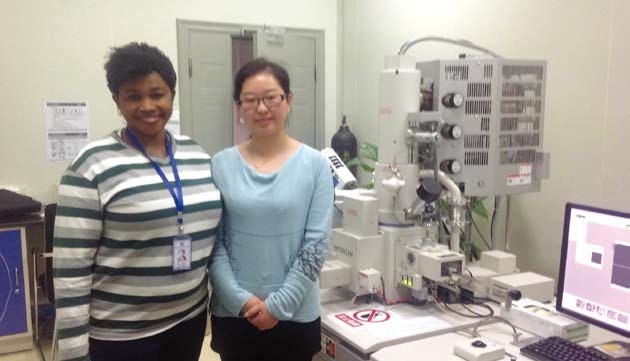Anake in lab with her host at IPE, CAS Member Prof. ZHANG Suojiang. (Photo by SONG J.)
Now with access to state-of-the-art experiment equipment and techniques here, eventually Anake got a chance to unravel the mystery seated in the extremely tiny particles, which had long troubled her.
“My research skills have been sharpened, through exposure and access to sophisticated analytical instruments. I believe this will make the research work visible in high- impact journals,” Anake commented on her study and work at IPE with optimism, in a talk with the author occurring in late October 2015, days before her flying back to Nigeria.
A chemist seeking to solve environment problems that border on human health, Anake is very concerned about the health effects of the tiny particles in the atmosphere — known as PM2.5 due to their grain sizes less than 2.5 µm— generated by mixed sources, including the booming industries in her country. “We have lots of industries in Nigeria, like oil recovery and petrochemical, metal melting, cement production, construction and others. Yes, they create wealth, but in the mean time they also cause problems: they produce PM2.5 with pollutants adhering to them. Therefore while formulating the research for my PhD thesis, I want to do something to deal with this,” she explained.
Even in the vicinity of the place where she is studying, the Covenant University in Ota of Nigeria, Anake narrated, they have a lot of industries. The landscapes have prompted her to pursue research to track the particles, in the hope of finding out if any connection exists between the pollutants and increased occurrence of respiratory diseases. “We are very concerned because there is no emission control of such pollutants. Nor is there any suitable solution to trap the particles.”
“They are thinner than hair size and can be inhaled by people. They go straight to the lungs, and get stuck in the organs of the body. What makes it worse is the fact that they are not just particles. They have pollutants adhering to it, including trace metals, some of which are carcinogenic.”
Noting the dearth of data showing chemical speciation and health risks associated with PM2.5 particulates, especially from heavily industrialized areas, and no convincing evidence on the part of regulatory bodies to enforce stricter emission limits, she began to take action.
